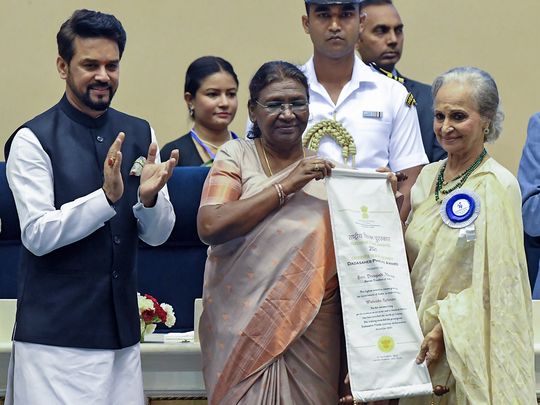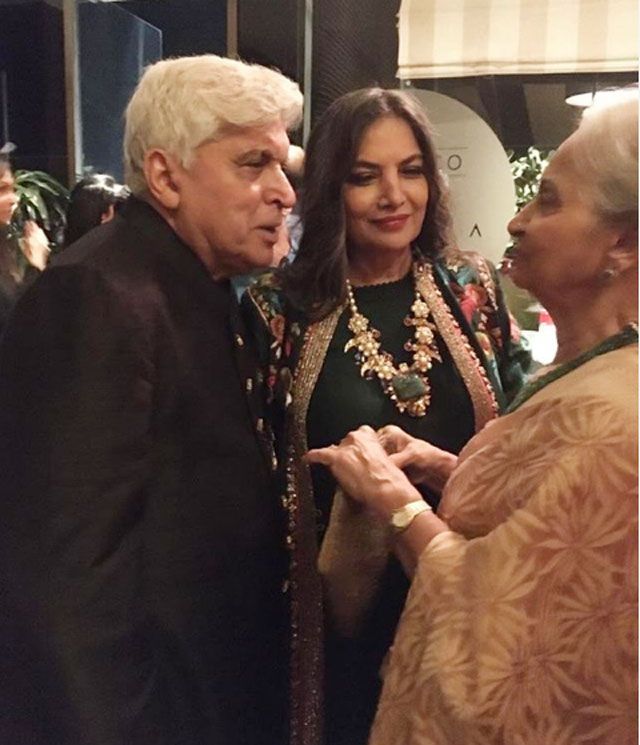
On Oct. 17, India’s President, Draupadi Murmu, presented the Dadasaheb Phalke Award to Waheeda Rehman at the 69th National Film Awards. This is the nation’s most highly regarded and prestigious recognition for a lifetime’s contribution to Indian cinema. Rehman, it is universally recognised, richly deserves it.
Why? Because she is one of the few actors in Bollywood who is equally applauded for being a star and a thespian. What is more, in an industry plagued by scandals and salacious gossip, she has maintained a rare dignity and poise throughout her sixty-seven year spell on Indian celluloid.
Few know that Rehman was born in the South, in Chengalpattu, Tamil Nadu. Her first break was in Telugu cinema in Rojulu Marayi (1955). She was only 15 when the shooting started. But it was Guru Dutt who brought her to Mumbai, casting her as his lead in C.I.D. (1957). No doubt, in due course, she teamed with hugely successful Bollywood cinematic superstars including Dev Anand, Dilip Kumar, Rajendra Kumar, Dharmendra, Sanjeev Kumar, Shashi Kapoor, Rajesh Khanna, and Amitabh Bachchan.
She also made memorable films with legendary and internationally renowned directors such Satyajit Ray, Raj Kapoor, Bimal Roy, Dev Anand, Vijay Anand, Yash Chopra, Hrishikesh Mukherjee, Shakti Samanta, Ramesh Sippy and Mani Ratnam. But it was Guru Dutt who drew out her inner talent to an extraordinary flowering.
Waheeda Rehman became Guru Dutt’s muse. It was he who captured the sheer lyricism and lambency of her cinematic presence, which was to distinguish her from her numerous contemporaries and competitors. Those who wish best to appreciate her versatile virtuosity will find it at its memorable best in three films, Pyaasa (1957), Kaagaz Ke Phool (1959), and Chaudavin Ka Chand (1960). It was Guru Dutt’s brilliant direction, with his distinct, signature close ups of Rehman that most revealed her inner luminosity on the big screen.
Exploring the themes of alienation, disillusionment, and social injustice, Pyaasa was a landmark film in Indian cinema. It was overtly progressive and romantic-Marxist in its ideological orientation. Rehman’s performance as Gulabo, a sex worker, was praised by critics and audiences alike.
She portrayed the character with sensitivity and dignity, bringing out her vulnerability and strength. She also shared a great chemistry with Guru Dutt, who played the poet Vijay. The film was a commercial and critical success and established Rehman as a star.

The following two movies, Kaagaz Ke Phool (1959), and Chaudavin Ka Chand (1960), were quite different, with Rehman playing the dissimilar roles with aplomb. In Chaudavin ka Chand (The Moon on the 14th Day), she is the innocent but vivacious romantic attraction not only of a young man, played by Guru Dutt, but of his mentor and benefactor too. The latter ends of sacrificing his life — and love interest — for the former. The plot of this Muslim social drama rests on the complications of the accidental sightings of a cloistered beauty.
The most important of these three and arguably a cinematic masterpiece, Kagaaz ke Phool (Paper Flowers) is self-referential, autobiographical, and very tragic in more ways than one. Rehman almost plays herself, a young, accidentally discovered actor, who becomes a famous movie star under the tutelage of a film maker who is a maverick genius. The film, which bombed at the box office, also foreshadowed, some say, the gifted, melancholic and alcoholic Guru Dutt’s suicide a few years after.
Leading lady for two decades
After her Guru Dutt phase, Rehman continued to deliver unforgettable performances in films such as Teesri Kasam (1966), Guide (1965), Ram Aur Shyam (1967), Neel Kamal (1968), Khamoshi (1970), Reshma Aur Shera (1971), Kabhi Kabhie (1976), Trishul (1978), Namkeen (1982), and Lamhe (1991), to name a few. After being a leading lady for two decades, she made a comeback on the silver screen in the early 1980s in matronly and motherly roles. In this avatar too, she distinguished herself in films as diverse and hugely successful, ranging from Namak Halaal (1980) to Rang De Basanti (2006).
Prior to the Dadasaheb Phalke Award, Rehman had won the Filmfare award for the best actress not once but twice (Sahib Bibi our Ghulam, 1962 and Neel Kamal, 1968). She had also won the Chicago International Film Festival best actress award for her performance in Guide (1965), and the National Award for the Best Actress (Reshma our Shera, 1971) in addition to Padma Shri (1972) and Padma Bhushan (2011).
With over 90 movies to her credit, Waheeda Rehman is undoubtedly a legend in Indian cinema. She displayed her range and talent in various genres and roles, including comedy, romance, drama, thriller, action, suspense, and musicals, playing heroine, supporting actress, and character roles. An accomplished danseuse in addition to a great actor, Rehman’s sheer brilliance and versatility have entertained and enchanted generations of audiences.
With her grace, charisma, dignity, poise, and professionalism, she continues to inspire generations of filmmakers, co-actors, and audiences not only in India or in the subcontinent, but also a wider, serious cinema-loving public across the world. Congratulations, Waheeda-ji, on your splendid achievement.









